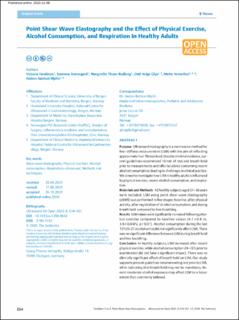Point Shear Wave Elastography and the Effect of Physical Exercise, Alcohol Consumption, and Respiration in Healthy Adults
Taraldsen, Victoria; Tomasgard, Sunneva; Rudlang, Margrethe Thune; Gilja, Odd Helge; Vesterhus, Mette; Mjelle, Anders Batman
Journal article, Peer reviewed
Published version

View/
Date
2020Metadata
Show full item recordCollections
- Department of Clinical Science [2395]
- Registrations from Cristin [10402]
Abstract
Purpose Ultrasound elastography is a noninvasive method for liver stiffness measurement (LSM) with the aim of reflecting approximate liver fibrosis load. Despite minimal evidence, current guidelines recommend 10 min of rest and breath hold prior to measurements and offer no advice concerning recent alcohol consumption, leading to challenges in clinical practice. We aimed to investigate how LSM in healthy adults is influenced by physical exercise, recent alcohol consumption, and respiration.
Materials and Methods 42 healthy subjects aged 21–36 years were included. LSM using point shear wave elastography (pSWE) was performed in five stages: baseline, after physical activity, after registration of alcohol consumption, and during breath hold compared to free breathing.
Results LSM values were significantly increased following physical exercise compared to baseline values (4.1±0.8 vs. 3.8±0.8 kPa, p=0.01). Alcohol consumption during the last 72 h (0–27 alcohol units) did not significantly affect LSM. There was no significant difference between LSM during breath hold and free breathing.
Conclusion In healthy subjects, LSM increased after recent physical exercise, while alcohol consumption 24–72 h prior to examination did not have a significant impact. There was no clinically significant effect of breath hold on LSM. Our study supports present guidelines recommending rest prior to LSM, while indicating that breath hold may not be mandatory. Recent moderate alcohol exposure may affect LSM to a lesser extent than commonly believed.
